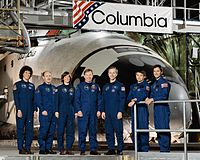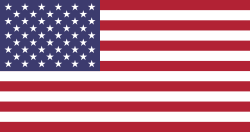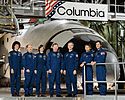STS-50
| Missionsemblem | |||||
|---|---|---|---|---|---|
 | |||||
| Missionsstatistik | |||||
| Missionsnavn: | STS-50 | ||||
| Rumagentur: | NASA | ||||
| Rumfartøjets navn: | Columbia (12) | ||||
| Antal besætningsmedlemmer: | 7 | ||||
| Affyringsrampe: | 39A KSC | ||||
| Opsendelse: | 25 Juni 1992 | ||||
| Landing: | 9 Juli 1992 | ||||
| Landet på: | KSC | ||||
| Varighed: | 9 dage | ||||
| Foto af besætningen | |||||
 | |||||
| Navigation | |||||
| |||||
STS-50 var Columbias 12. rumfærge-mission, der blev opsendt den 25. juni 1992 og vendte tilbage den 9. juli 1992. Det var en spacelab-mission med fokus på bioteknologi og væskefysik.
Columbia landede for første gang på Kennedy Space Center pga. dårligt vejr på Edwards Air Force Base.
Besætning

 Richard Richards (kaptajn)
Richard Richards (kaptajn)
 Kenneth Bowersox (pilot)
Kenneth Bowersox (pilot)
 Bonnie Dunbar (1. missionsspecialist)
Bonnie Dunbar (1. missionsspecialist)
 Ellen Baker (2. missionsspecialist)
Ellen Baker (2. missionsspecialist)
 Carl Meade (3. missionsspecialist)
Carl Meade (3. missionsspecialist)
 Lawrence DeLucas (1. nyttelastspecialist)
Lawrence DeLucas (1. nyttelastspecialist)
 Eugene Trinh (2. nyttelastspecialist)
Eugene Trinh (2. nyttelastspecialist)
Missionen
Hovedartikler:
Eksterne henvisninger
- STS-50 NASA (engelsk)
| ||||||||
Medier brugt på denne side
Forfatter/Opretter: By Rei-artur (diskussion · bidrag)., Licens: CC-BY-SA-3.0
Venus/female symbol.
The STS-50 crew portrait includes (from left to right): Ellen S. Baker, mission specialist; Kenneth D. Bowersox, pilot; Bonnie J. Dunbar, payload commander; Richard N. Richards, commander; Carl J. Meade, mission specialist; Eugene H. Trinh, payload specialist; and Lawrence J. DeLucas, payload specialist. Launched aboard the Space Shuttle Columbia on June 25, 1992 at 12:12:23 pm (EDT), the primary payload for the mission was the U.S. Microgravity Laboratory-1 (USML-1) featuring a pressurized Spacelab module.
This scene represents the end of NASA's STS-1 mission and the beginning of STS-2 in that the orbiter Columbia is arriving at Kennedy Space Center in Florida to begin the lengthy process of preparing it for STS-2. The vehicle landed at Dryden Flight Research Center on April 14 after an historic 2 1/3 day flight in Earth orbit. It was mated to this 747 aircraft, titled NASA 905, and flown over the USA to its Florida destination. It was later removed from atop NASA 905 and moved to the orbiter processing facility for the beginning of refurbishment.
Forfatter/Opretter: Rei-artur (diskussion · bidrag), reshaped by F l a n k e r (talk), Licens: CC-BY-SA-3.0
symbol of Mars. 400 × 400 pixels nominal dimensions, line 45 pixel tick, circle 295 × 295 pixel, not joined with arrow. Colour: red=0 green=0 blue=140.
![]() Vektorgrafikken blev lavet med Inkscape.
Vektorgrafikken blev lavet med Inkscape.
The crew patch of STS-50, United States Microgravity Laboratory-One (USML-1), captures a Space Shuttle traveling above Earth while trailing the USML banner. The Orbiter is oriented vertically in a typical attitude for microgravity science and in this position represents the numeral 1 in the mission's abbreviated title. This will be the first in a series of USML flights where the primary objective is microgravity science, planned and executed through the combined efforts of our country's government, industry, and academia.
Visible in the orbiter's payload bay are the Spacelab module, and the extended duration Orbiter "cryo" pallet which is being flown for the first time on STS-50. The small g and Greek letter mu on the Spacelab module symbolize the microgravity environment being used for research in the areas of materials science and fluid physics. The large block letter U extends outside of the patch's perimeter, symbolizing the potential for the experiments on this flight to expand the current boundaries of knowledge in microgravity science.
The Stars and Stripes of the USML block letter and the U.S. landmass visible in the Earth scene below the Orbiter reflect the crew's pride in the United States origin of all on-board experiments.







